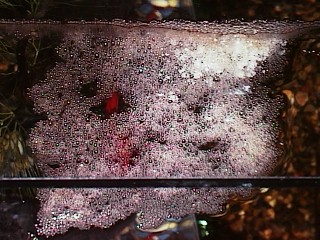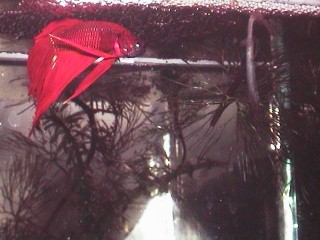BREADING A SIAMESE FIGHTER FISH
Any healthy mature male Betta will all ways be ready to spawn. The females that are ready to spawn can be spotted easily; look for a small white tube protruding from the bottom of her swollen stomach.
When you have a ready and willing pair, go ahead and setup the spawning tank. I use a 2 gallon rectangular tank. No filter is needed in this tank as it will only be in use for a small period of time. It helps the male to add a sprig of a floating plant or other floating object around which he will build a bubble nest. The optimum temperature for spawning Bettas is around 82°F (28°C).
After the male has spent a little time getting himself adjusted to his new home, the female is added. It's best to put the female in a quart jar or similar container, and float this in the tank with the male. This lets them get acquainted with one another and cuts down on the sparring session that sometimes precedes the spawning act.
When the male has his nest built and the pair has settled down a bit, the female can be released from the jar. Spawning should begin shortly. The male will embrace the female who releases a few eggs, the male will collect the eggs and blow them up into his nest. This act is repeated for a few hundred times, until the female is depleted of eggs. At this time it's best to remove the female and leave the male to take care of the eggs. He will replace any eggs that fall from the nest and guard the eggs from any threats, real or imagined.
The eggs will hatch in about 24 to 36 hours. The male can be left with the fry for another 2 days or can be removed at hatching.
The fry are capable of eating baby brine shrimp as a first food. Micro worms make a good first food also.
They can be left in the spawning tank for up to 2 weeks. Make daily 20% water changes to keep the water in good condition. At 2 weeks they need to be moved to a larger tank of about 10 gallons. Just empty the whole 2 gallon tank into the 10 gallon tank. You can gradually add more water daily. And at this time a sponge filter can be added and you can start adding crushed flake food to their diet.
If you have a small brood of around 50 fry, they can be raised to about half an inch long in this tank. Then the males will need to be separated and placed into individual jars or other containers to prevent fighting.
Bettas are extremely susceptible to a disease called "Velvet", also sometimes called "Rust". The official or scientific name is Oodinium. It is a parasitic disease, that is that there is a living organism actually feeding off of the body fluids of it's host, the Betta. Common symptoms include listlessness, gold, rusty or grey patches on the body of the fish, lack of appetite, and general weakness or lack of energy, and sometimes the avoidance of light. if you notice any of these symptoms you can bet you Betta has Velvet.
Fortunately Velvet is very easy to cure. Common table salt added at the rate of 1 teaspoon per gallon will do it, or an even more dependable cure is to use any fish medicine that contains copper as the main ingredient. (Note that copper is deadly to snails, crabs and any other invertebrates, but it is generally safe for the bacteria colony that filters your aquarium.
Young Bettas are most susecptable to Velvet and I recommend adding a teaspoon of salt to all Betta fry tanks as a preventative. And it wouldn't hurt a thing to use salt in all Betta tanks or jars.
Bettas are generally tough fish, they can survive where a lot of other fish couldn't, their only real weakness is Velvet. So if you are armed with the cure you will alleviate about 90% of the health problems with Bettas.
Note: If you have a lonely male Betta and want to add a little excitement to his life every now and then. Just hold a small mirror up to his tank and watch him come to life with threat displays to his own reflection. That's whats happening n the picture at the top of this page. Funny stuff, just don't forget to remove the mirror after a while.
Bettas come in a rainbow of colors. The most sought after is the solid black. Why? They are rare because there is a sterility link with the gene for black, and the only way you can get black Betta is by crossbreeding the black males with another color female, and then only a minority of the fry will be black. Personally I like the wild coloration, or the solid reds.
Note 2: Male Bettas are a danger only to other male Bettas and sometimes female Bettas. They are not a danger to most other species of fish and are in fact a frequent victim of fin nippers such as Tiger Barbs.
This is one of the bubble nests.
This nest is nearly done wait until the female drops her eggs and the male catches them then remove the female.
Any probs with breading
During breading if you find the male attaks the female remove her emediantly and wait a week some males can be too old and past breading so trade one with me and you will have a perfect breading male females are identified witha small white dot on ther stomach.
DIFFCULTIES BREADING.
Even though these fish are one of the easiest to breed if you decide to breed them give me the date your doing it and email me it. I will ring you up on the day and help you get through it without a prob. |

 |